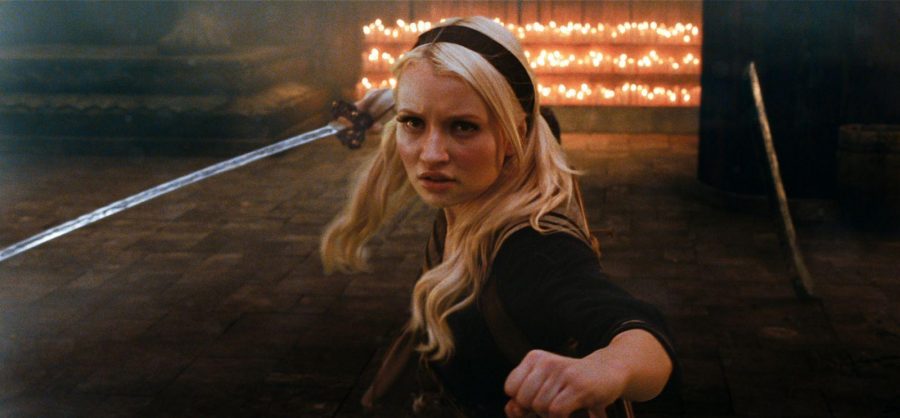As an 18-year-old male, I should be the type of person who would enjoy a movie about prostitutes battling it out with samurais, Nazi zombies, orcs, and robots. Sounds like every teenage boy’s most epic fantasy, right? That’s what I thought when I first saw the trailer for Zach Snyder’s “Sucker Punch.” Unfortunately, at the time I was sitting in a Peter Pan outfit playing with Legos in my tree fort so my judgment must have been clouded. If this movie had been released about five years ago, I would have been giggling with excitement at the thought of a 20-something-year-old floozy in a school girl outfit slicin’ and dicin’ undead beasties with a samurai sword, yet this movie was supposedly geared towards geeks my age. If I didn’t enjoy this film, then who else would?
This girl (Emily Browning), simply known as Babydoll, and her sister live in a house with their mother who ends up dead within the first minute. I don’t think there’s ever an explanation why she died. The evil lecherous step-father then subjects the girls to abuse and other unsavory deeds. Babydoll decides that she has had enough, steals step daddy’s gat and accidentally shoots her sister in the face. It’s a feel good movie. Then Babydoll gets sent to the local insane-asylum which could easily pass as Jeffrey Dahmer’s vacation home. This is where the story gets confusing. Evil step daddy signs Babydoll up for a lobotomy, and right before the stabby-utensil penetrates her brain, she gets transported to some sort of alternate universe, which makes as much sense as Rob Shneider’s career.
So in this alternate reality, the asylum is actually a 1940s-esque brothel run by a total psychopath, where Babydoll makes a few hooker friends named Rocket (Jena Malone), her big sister Sweet Pea (Abbie Cornish), Blondie (Vanessa Hudgens), and Amber (Jamie Chung). Each of them have a dance she has to perform in front of wealthy and gross old men, so as the new girl Babydoll is instructed to “feel the music” and dance her heart away in front of the head mistress lady and the club owner. It turns out that Babydoll’s dancing is so majestic that her mind gets transported to a snowy temple where some white guy in a Japanese kimono instructs her that there are a few items she has to find in order to escape from the brothel. At this point, my head literally exploded in the movie theater and the poor cleaners had to piece it back together with glue and tape.
She then proceeds to fight giant demonic samurais in a ridiculously short skirt and when she’s done, she returns to “reality” and the dance is finished. It’s like “Inception” but even more ridiculous. The movie carries on like this for another hour and a half, each dance taking Babydoll to another reality until all the items are found. This is actually the whole plot. Not to mention that it comes off as ridiculously misogynistic due to the fact that the ditzy female characters in this movie are constantly beaten down by the dominant male characters like helpless rag-dolls.
Simply put, Snyder, who also directed “300,” thought that structuring a movie like a modern-day video game would be a solid idea and teenage males everywhere would be drooling in ecstasy. This was a huge mistake on his part. Take Edgar Wright’s “Scott Pilgrim vs. the World.” This film was a far more masterful example of how videogames and film could happily live hand-in-hand. Wright, who also directed “Shaun of the Dead,” “Hot Fuzz,” and the hilarious British cult television show “Spaced,” is a more talented director in almost every facet. While “Scott Pilgrim” was originally a graphic novel, the marriage between old Nintendo games and the modern day indie culture in Toronto made sense for a movie adaptation. Not to mention old Nintendo games have personality.
When Snyder decided to fuse modern-day shooters, sci-fi, and fantasy games with his deeply convoluted love-child, it formed into this giant, bland, cesspool of immaturity. When you put Mario next to “Call of Duty,” the former is a classic infused in popular culture and the latter is an outlet for adolescent foul-mouthed children. I’ll bet you can guess where “Sucker Punch” fits in that analogy.
It’s somewhat insulting to my intelligence that Zach Snyder attempted to trick me into enjoying this film by trying to mask a horrible storyline with exposed flesh and flashy fight scenes. The worst aspect of “Sucker Punch” is that it’s not shot in a tongue-in-cheek b-movie style that Quentin Tarantino has nailed time and time again. It’s actually meant to have a serious tone which is laughable considering the content. Not to mention that making this film PG-13 was mistake number one, because that instantly lowers the maturity level in the hands of a mediocre director. After the first few trailers started showing up a few months ago, I expected the film to at least be exciting to watch. While some of the fight scenes are mildly amusing at best, “Sucker Punch” ultimately comes off as a convoluted mess with very little personality.
Written by Hank Brown. This article originally appeared in the April 2011 issue.



